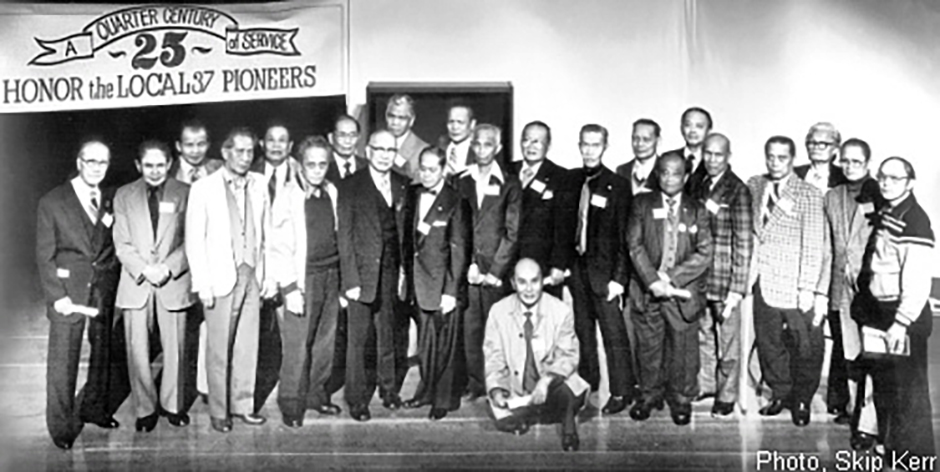The Reform Movement of Local 37
The Work of Silme Domingo and Gene Viernes

On June 1, 1981 Silme Domingo and Gene Viernes, Secretary Treasurer and Dispatcher of the Alaska Cannery Workers Union- Local 37, International Longshoremen’s and Warehousemen’s Union (ILWU), were gunned down in broad daylight at their Pioneer Square union hall.
Silme and Gene had been active union members since their teens, working side by side with their fathers in the Alaska canneries. It was in those canneries that Silme and Gene and many other second generation Filipino Americans and Asian Pacific Islanders learned that the substandard working and living conditions remained the same through both generations. However, Silme and Gene were also part of a new generation armed with college educations and spurred to activism by the anti-war and ethnic awareness movements of the 60’s and 70’s. In the early 1970’s, under the leadership of Nemesio Domingo, Silme’s older brother, Silme and Gene and others formed the Alaska Cannery Workers’ Association (ACWA). The ACWA enabled these young people to file three class action discrimination lawsuits against the Alaska canneries charging discriminatory practices in employment and housing. Two of those lawsuits were won in federal court in the 1980’s resulting in millions of dollars to cannery workers as a result of suffering under these discriminatory practices.
However, Silme and Gene realized that the real source of change for workers in Alaska would only come through reforming the union that represented the cannery workers. Their search for justice led them to seek out former progressive Local 37 leaders in Seattle and the West Coast like Chris Mensalvas, Leo Lorenzo, Mario Hermosa, and Pablo Valdez. Through these men and many others, Silme and Gene learned of the militant labor history of Local 37. In 1977 these manongs served as the inspiration for Silme and Gene to lead a reform movement in Local 37 that would force the union to address the needs of its members and implement fair hiring and dispatching procedures.
As a result of the reform movements’ successful work, Silme and Gene were elected officers of Local 37 in 1980 under a platform of ridding the union of bribery, vote buying, violence and intimidation. But Gene and Silme also learned from their discussions with the manogs and through historical research that Local 37 was founded on the principal of international solidarity – that their workers’ struggles were tied with the struggles of workers in the Philippines and all over the world. It was in the course of implementing this guiding principal that ultimately caused Silme and Gene’s deaths.
Silme and Gene were also members of the Union of Democratic Filipinos (KDP) and leaders in the U.S. based movement for democracy in the Philippines. At the time of their deaths, the Philippines had been under the dictatorship of Ferdinand and Imelda Marcos since 1972. Like their predecessors, Chris Mensalvas and Carlos Bulosan, Silme and Gene sought to use their union positions to support the workers’ struggle for democracy in the Philippines and, therefore, to fight against the Marcos dictatorship. The ILWU with its long militant history in supporting workers’ struggles in other countries was a long time friend to the Philippine struggle for democracy.
In April 1981 Gene Viernes took his first trip to the Philippines to visit his relatives and to meet with Philippine labor leaders of the Kilusang Mayo Uno (KMU), May First Movement. There, Gene Viernes spoke to thousands at a KMU workers’ rally and delivered an invitation to KMU’s President to attend the international convention of the ILWU in Hawaii to speak about workers’ conditions in the Philippines. Unable to safely leave the Philippines, the KMU Chairman, Felixberto Olalia, Sr., sent with Gene greetings to the ILWU convention in Hawaii, an appeal for support and an invitation for the ILWU to send a delegation to the Philippines to investigate the conditions faced by workers under the Marcos dictatorship. Olalia’s statement led to the passage of a highly significant and controversial ILWU resolution to send an investigating team for those purposes.
Less than one month later, Silme and Gene were murdered as they worked in their offices and the ILWU investigating team was never sent.
Through eight years of organizing and legal work led by the Committee for Justice for Domingo and Viernes (CJDV), three members of a local gang were found guilty in their roles in the murders and sentenced to life imprisonment without parole. As a result of a civil suit filed in Federal Court, Philippine dictators Ferdinand and Imelda Marcos were found liable in the murders of Gene and Silme and ordered to pay the families $15 million. Former President of Local 37, Tony Baruso, was put on trial in 1990 and also sentenced to life imprisonment without parole for his role in the murders.
What was uncovered by the CJDV was a murder plot hatched and paid for in Manila and carried out by local gang members. However, the work that the murderers sought to stop was only strengthened by the many people that stepped forward in the wake of Silme and Gene’s murders.
Today the Alaska Cannery Workers Union survives as part of the marine division of the ILWU under the name of Region 37, Inland Boatmen’s Union and is still in the hands of those that worked with Silme and Gene in the reform movement. In 1986, the Filipino people overthrew the Marcos dictatorship and started the difficult process of implementing democracy in the Philippines.
